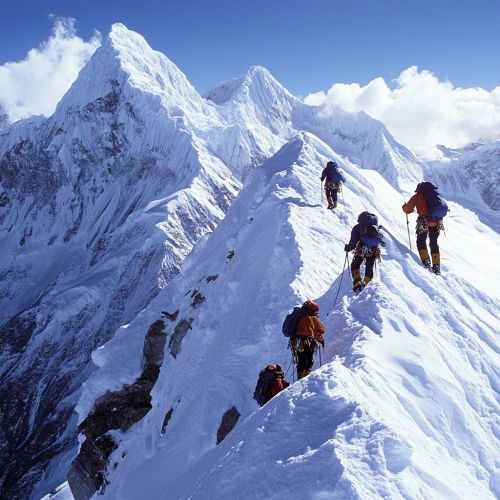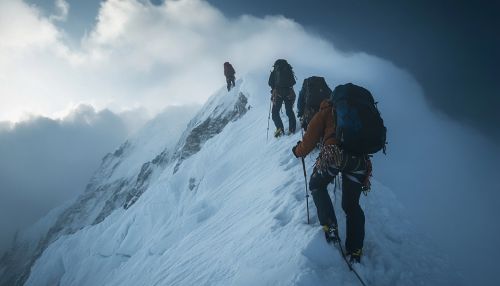Sherpa
Introduction
The term "Sherpa" refers to an ethnic group native to the mountainous regions of Nepal, particularly the Solu-Khumbu region. Sherpas are renowned for their exceptional mountaineering skills and have played a crucial role in the exploration of the Himalayas, including the first successful ascent of Mount Everest by Sir Edmund Hillary and Tenzing Norgay in 1953. This article delves into the history, culture, and contributions of the Sherpa people.
History
Origins
The Sherpa people are believed to have migrated from the eastern regions of Tibet to Nepal around 500 years ago. The term "Sherpa" is derived from the Tibetan words "Shar" meaning "east" and "Pa" meaning "people," indicating their eastern Tibetan origins. They settled in the Solu-Khumbu region, which lies at the base of Mount Everest.
Early Settlements
The early Sherpa settlements were primarily agrarian, with communities engaging in farming and animal husbandry. They cultivated crops such as barley, potatoes, and buckwheat, and raised yaks, which were essential for their livelihood. The harsh mountainous terrain and climate necessitated a self-sufficient lifestyle.
Culture
Language
The Sherpa language, known as "Sherpa" or "Solu-Khumbu Sherpa," belongs to the Tibeto-Burman language family. It is closely related to Tibetan and is written in the Tibetan script. The language is an integral part of Sherpa identity and is used in daily communication, rituals, and oral traditions.
Religion
Sherpas practice Tibetan Buddhism, which profoundly influences their culture and daily life. The Nyingma and Kagyu schools of Tibetan Buddhism are particularly prominent among the Sherpa community. Monasteries, known as "gompas," play a central role in religious and social activities. The Mani Rimdu festival, celebrated at the Tengboche Monastery, is one of the most significant religious events for Sherpas.
Social Structure
Sherpa society is organized into clans, known as "ru," which are patrilineal and exogamous. Each clan has its own distinct lineage and traditions. The community is also characterized by a strong sense of cooperation and mutual support, which is essential for survival in the harsh mountainous environment.
Mountaineering
Early Expeditions
Sherpas gained international recognition for their mountaineering skills during the early 20th century when Western explorers began attempting to summit the peaks of the Himalayas. Sherpas were employed as porters and guides due to their exceptional physical endurance and knowledge of the terrain.
Notable Achievements
The most famous Sherpa mountaineer is Tenzing Norgay, who, along with Sir Edmund Hillary, became the first to reach the summit of Mount Everest on May 29, 1953. This historic achievement brought global attention to the Sherpa community and their mountaineering prowess.


Modern Mountaineering
In contemporary times, Sherpas continue to be indispensable in the field of high-altitude mountaineering. They serve as guides, porters, and support staff for expeditions to peaks such as Everest, Lhotse, and Makalu. Sherpas have also set numerous records, including multiple ascents of Everest and other 8,000-meter peaks.
Economy
Tourism
Tourism, particularly trekking and mountaineering, is a significant source of income for the Sherpa community. The influx of tourists has led to the development of infrastructure such as lodges, restaurants, and trekking agencies in the Solu-Khumbu region. The Sherpa people have adapted to this economic shift while maintaining their cultural heritage.
Agriculture
Despite the growth of tourism, agriculture remains an important aspect of the Sherpa economy. The cultivation of crops and the rearing of yaks provide sustenance and supplementary income. The harsh climate and rugged terrain pose challenges, but traditional farming practices have been adapted to optimize yield.
Challenges
Environmental Issues
The increasing number of tourists and mountaineering expeditions has led to environmental concerns, including waste management and the degradation of natural habitats. Efforts are being made to promote sustainable tourism and conservation practices to mitigate these impacts.
Socioeconomic Changes
The influx of tourism has brought about significant socioeconomic changes in Sherpa society. While it has provided economic opportunities, it has also led to cultural shifts and challenges related to modernization. Balancing economic development with the preservation of cultural heritage is a critical issue for the Sherpa community.
